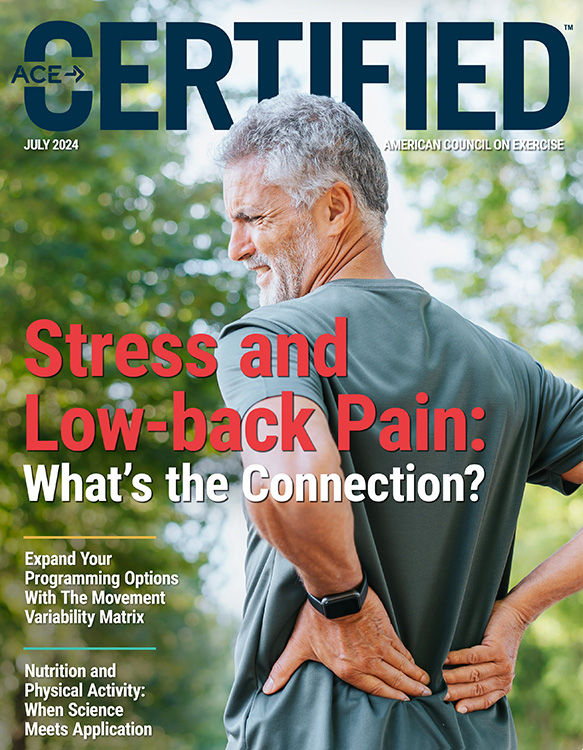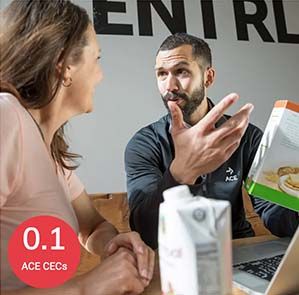
Nutrition and physical activity are two major components of health and wellness but they are often treated as separate factors. Dr. Erin Nitschke, ACE Certified Health Coach, Fitness Nutrition Specialist, subject matter expert and health and human performance college professor, recently collaborated with other industry experts to discuss evidence-based guideline development for nutrition and physical activity. The purpose of this webinar, Nutrition and Physical Activity: When Science Meets Application, was to ensure that health and exercise professionals understand how guidelines for the general population are formed so they can take the next step of providing individualized, practical and evidence-based programming for their clients.
In this follow-up question and answer, Dr. Nitschke discusses a wide range of related issues, including how to talk to clients about topics that haven’t yet been thoroughly researched and the interconnectedness of nutrition and physical activity, and provides a “Research Credibility” checklist that can be used to distinguish between valid research studies and those that are less rigorous or biased.
Q: What do I say to my clients when they ask me about topics, supplements or approaches that are either too challenging to study (sometimes for ethical reasons) or haven’t yet been studied? In other words, what do I say when there just isn’t enough information available? I know that some people want to discount anything that hasn’t yet been proven, but is that always the right approach?
A: I think it is important to clarify that science does not “prove” anything. Research findings can be used to find correlations and relationships and associations between variables, but they don’t prove or disprove. The results of any study suggest or provide insight for further study and generally either support or refute the proposed research question.
When it comes to advising clients and navigating conversations around specific scientific topics, dietary supplements or approaches that pose challenges due to insufficient study or ethical concerns, transparency and cautious guidance are essential. Here are some guidelines to help you in these situations:
- Transparency: Be upfront with clients about the limitations of available research, or the lack thereof, concerning certain topics, supplements or approaches. Explain that while some strategies may show promise anecdotally or in preliminary studies, there isn't enough concrete evidence to fully support their efficacy or safety.
- Risk assessment: Evaluate the potential risks and benefits of the topic, supplement or approach based on the available information. If there is a significant lack of evidence or if ethical concerns are present, err on the side of caution. Highlight potential risks and advise against adopting the approach until further research is available.
- Individualized approach: Recognize that each client is unique, and what works for one person may not work for another. Consider factors such as medical history, current health status and personal goals when discussing unproven topics or supplements.
- Encourage informed decision-making: Empower clients to make informed decisions by providing them with all available information, including the uncertainties and risks associated with the topic, supplement or approach in question. Offer resources for further exploration and encourage them to consult with other healthcare professionals if needed.
- Monitor and adapt: If a client insists on trying a particular supplement or approach despite limited evidence, monitor their progress closely and be prepared to adapt the plan if any adverse effects occur or if desired outcomes are not achieved.
While the medical profession tends to prioritize evidence-based practices, it’s crucial to acknowledge that the absence of evidence does not necessarily equate to evidence of absence. However, caution should prevail when considering unproven or under-researched topics, supplements or approaches, particularly when potential risks are involved. It’s always better to prioritize safety and informed decision-making over experimental interventions with uncertain outcomes.
Q: Can you explain a bit about the interconnectedness between nutrition and physical activity? I know there is research demonstrating that one often has a positive effect on the other. Conversely, being mindful about one doesn’t allow a person to ignore the other. How can I educate my clients about the symbiotic nature between these two components of health?
A: The relationship between nutrition and physical activity is both symbiotic and crucial for overall health and well-being. As a health and exercise professional, it is essential that you educate your clients about this interconnectedness to help them achieve their goals effectively.
Here are six of my “pro tips” for accomplishing this:
- Highlight the importance of balance: Remind your clients that both nutrition and physical activity play integral roles in achieving and maintaining optimal health. While nutrition provides the body with essential nutrients for energy and repair, physical activity helps to strengthen muscles, improve cardiorespiratory health and enhance overall fitness.
- Explain the energy balance equation: Educate clients about the concept of energy balance, which involves balancing the calories consumed through food with the calories expended through physical activity. Help them understand that consuming nutritious foods in appropriate portions (for their individual needs) and engaging in regular physical activity are key components of achieving and maintaining a healthy weight.
- Demonstrate synergistic effects: Take an evidence-based approach. Share research and real-life examples demonstrating how nutrition and physical activity complement each other to enhance health and well-being outcomes. For instance, consuming a balanced diet rich in nutrients fuels physical-activity performance, while regular exercise can boost metabolism and promote better nutrient absorption.
- Offer practical guidance: Provide clients with practical tips and strategies for integrating healthy eating habits and regular physical activity into their daily lives. This could include assisting clients in identifying nutritious food combinations, prepping nutritious snacks, finding enjoyable forms of exercise and scheduling regular workouts.
- Encourage consistency and sustainability: Emphasize the importance of consistency and sustainability when it comes to nutrition and physical-activity habits. Encourage clients to focus on making small, gradual changes that they can maintain over the long term rather than quick-fix solutions. Reinforce the fact that change is a nonlinear process, and that is O.K.!
- Address individual needs and goals: Recognize that each client is unique and has different nutritional requirements, fitness levels and goals. Tailor your guidance to their specific needs and preferences, considering factors such as dietary restrictions, food preferences and fitness aspirations.
By educating clients about the symbiotic relationship between nutrition and physical activity, you can empower them to make informed choices and adopt lifestyle habits that promote overall health and well-being. Encouraging a balanced approach that prioritizes both nutrition and physical activity will ultimately help clients achieve their health and fitness goals more effectively.
Q: What is considered a valid research study? What distinguishes the merit or validity of different types of research studies from one another?
A: Valid research studies are characterized by several key factors that signify their merit and validity. As a health and exercise professional, it’s important to recognize these distinctions to critically evaluate research findings and apply them effectively in practice.
Here are some criteria for determining the validity of different types of research studies that I like to use in my various classes:
- Research design: The design of a study greatly impacts its validity. Randomized controlled trials are often considered the gold standard for establishing cause-and-effect relationships because they involve random assignment of participants to different groups and typically include control groups for comparison. Observational studies, on the other hand, can provide valuable insights but are more susceptible to bias and confounding variables.
- Sample size and representativeness: The size and representativeness of the study sample are crucial for generalizability and statistical power. Larger sample sizes are generally more robust and provide more reliable results, while samples that accurately represent the target population enhance the external validity of the findings.
- Methodology and data collection: The methods used to collect data should be valid and reliable. Validated measurement tools and standardized procedures help ensure the accuracy and consistency of data collection. Additionally, studies with low risk of bias and clear protocols for data collection and analysis are more trustworthy.
- Statistical analysis: The statistical analysis methods used should be appropriate for the research question and data type. Studies that employ rigorous statistical techniques and report effect sizes, confidence intervals and p-values provide more reliable evidence compared to those with simplistic or inappropriate analyses.
- Peer review and publication: Publication in reputable peer-reviewed journals indicates that the study has undergone rigorous scrutiny by experts in the field. Peer review helps ensure the quality and validity of research findings by evaluating factors such as study design, methodology, analysis and interpretation.
- Conflict of interest and funding sources: Transparency regarding potential conflicts of interest and funding sources is essential for assessing the integrity and credibility of a study. Studies that disclose any conflicts of interest and adhere to ethical standards in research design and reporting are generally more trustworthy.
- Consistency with existing evidence: Valid research studies contribute to the body of scientific knowledge by building upon existing evidence and addressing gaps in understanding. Consistency with findings from previous studies and coherence with established theories lend credibility to new research findings.
By considering these criteria, we can evaluate the validity and merit of different types of research studies and make informed decisions about applying the findings in our practice with clients. Critical appraisal of research helps ensure that evidence-based recommendations are based on sound scientific principles and have the potential to positively impact client outcomes.
Research Credibility Checklist
Study Design
 |
Is the study design appropriate for the research question (e.g., randomized controlled trial, observational study)? |
 |
Are there clear inclusion and exclusion criteria for participants? |
 |
Does the study have a control group (for experimental studies)? |
Sample Size and Representativeness
 |
Is the sample size adequate to detect meaningful effects? |
 |
Does the study sample represent the target population accurately? |
Methodology and Data Collection
 |
Are the methods used to collect data valid and reliable? |
 |
Are the measurement tools validated and appropriate for the study's objectives? |
 |
Are there clear protocols for data collection and analysis? |
Statistical Analysis
 |
Are the statistical methods appropriate for the study design and data type? |
 |
Are effect sizes, confidence intervals and p-values reported? |
 |
Is there transparency in reporting statistical methods and results? |
Peer Review and Publication
 |
Is the study published in a reputable peer-reviewed journal? |
 |
Has the study undergone rigorous peer review by experts in the field? |
 |
Is the journal indexed in reputable databases such as PubMed or Web of Science? |
Conflict of Interest and Funding Sources
 |
Are potential conflicts of interest disclosed by the authors? |
 |
Is there transparency regarding funding sources for the study? |
 |
Could any conflicts of interest or funding sources potentially influence the study's findings or conclusions? |
Consistency with Existing Evidence
 |
Are the study findings consistent with previous research in the field? |
 |
Do the study results align with established theories and principles? |
 |
Does the study contribute new insights or address gaps in existing knowledge? |
Ethical Considerations
 |
Has the study received ethical approval from an appropriate review board? |
 |
Are participant rights and confidentiality protected? |
 |
Are any potential risks to participants minimized and disclosed? |
Practical Relevance
 |
Are the study findings relevant to the practice of health and exercise professionals? |
 |
Can the results be applied to real-world settings and client populations? |
 |
Do the study conclusions have implications for improving health outcomes or informing practice? |
This checklist comes in handy whenever you need to critically evaluate the credibility and validity of research studies. Use this before applying the research findings to your practice or providing recommendations to clients. This helps ensure that evidence-based decisions are grounded in sound scientific principles and have the potential to positively impact client outcomes.
Q: Can you share why conflict can be a good thing in science and research?
A: Great question! Conflict is both valuable and necessary. Overall, while conflict in research can feel uncomfortable, it plays a crucial role in advancing knowledge, ensuring the reliability and validity of scientific findings, and driving innovation within academic and scientific communities. I like to think of “conflict” through the lens of advancing knowledge and practice rather than as something to be avoided. To some degree, conflict naturally exists in science, because scientists are both inquisitive and skeptical; these two qualities are what drive us to ask tough questions and then engage in the consistent and persistent pursuit of knowledge.
Conflict in research serves as a catalyst for critical examination, enhancing the rigor and reliability of scientific inquiry. It stimulates innovation by encouraging researchers to explore alternative hypotheses and methodologies, leading to new discoveries and advancements. Conflict also acts as a form of quality control, facilitating the identification and correction of errors, biases and oversights. Through lively discourse and open dialogue, conflict fosters community engagement and collaboration, enriching the collective knowledge of the field. Importantly, it helps to avoid the pitfalls of groupthink by challenging prevailing assumptions and encouraging diverse perspectives. In essence, while conflict may be uncomfortable at times, its presence is integral to the progression of research, ensuring that scientific findings are robust, reliable and innovative.
Nutrition and Physical Activity: When Science Meets Application
Interested in learning more about how guidelines for the general population are formed so you can then take the next step of providing individualized, practical and evidence-based programming for your clients? In this recorded webinar, you’ll learn the differences between systematic reviews, evidence-based practice guidelines and position statements; how to apply critical thinking to scientific literature as it relates to health and fitness information and research; and how to help clients achieve their nutritional and physical activity goals by applying takeaways from the systematic review. Led by Sabrena Jo, PhD, ACE Senior Director of Science and Research and ACE Certified Health Coach, Personal Trainer, and Group Fitness Instructor, this dynamic group of experts brought their extensive knowledge to this informative webinar. In addition to Dr. Nitschke, the panel included Justin Robinson, RD, Board Certified Specialist in Sports Dietetics, Certified Strength and Conditioning Coach and Human Performance Dietitian, and Dr. Peggy Hamlett, ACE Certified Health Coach, Personal Trainer, Group Fitness Instructor, Medical Exercise Specialist, Fitness Nutrition Specialist and Therapeutic Exercise Specialist.
Expand Your Knowledge
Nutrition and Physical Activity: When Science Meets Application
Nutrition and physical activity are two major components of health and wellness but are often treated as separate factors. In this webinar, you’ll learn from a panel of industry experts, practitioners and scientists about the symbiotic relationship between these pillars as they discuss evidence-based guideline development for nutrition and physical activity. This webinar will ensure you understand how guidelines for the general population are formed so you can take the next step of providing individualized, practical and evidence-based programming for your clients.
Better Together: Combining Fitness and Nutrition for Powerful Results
This video training explores the individual and combined effects of physical activity and nutrition interventions provided by fitness professionals. You’ll gain knowledge of how to leverage multidisciplinary approaches that establish positive behavior changes in adults and learn how evidence from exercise and nutrition practitioner guidelines align with the ACE IFT® Model, along the health, fitness and performance spectrums.





 by
by 




